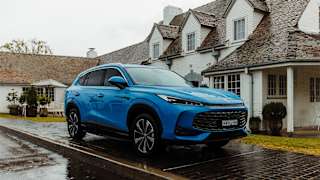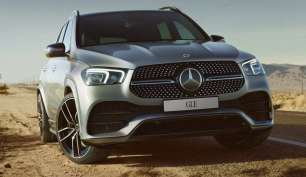If you can call a car that starts near two-hundred grand good value, then you have much more money than I do. But there is no escaping it: the new S-Class 2018 range is better value than before.
The starting point in the range is entry-grade S 350 d, which is $195,900 plus on-road costs.
Standard kit for that model includes 19-inch alloy wheels, leather trim, heated and cooled front seats, nappa leather-wrapped steering wheel, those great new headlights and the new ambient lighting system, a panoramic sunroof, head-up display, dark brown 'Eucalyptus' trim, auto-dimming rear-view and side mirrors, a wireless phone charging system, keyless entry and push-button start. The entire S-Class range now gets auto-closing doors and an electric boot lid, too.
The media system in the S 350 d includes sat nav with traffic monitoring, a 13-speaker Burmester sound system, digital TV, DAB+ digital radio, Apple CarPlay and Android Auto, and the 'Comand Online' system with internet capability.
Next up the model range is the S 400d L (at $222,500), and the S 450 L ($227,500) - both of which are specified identically. Over the base model car they feature the extended wheelbase, as well as electronically adjustable rear seats with memory function, side window blinds, a rear blind, rear climate control, and 20-inch wheels.
The S 560 sees the price head north to $270,000 (for the short-wheelbase model, which loses the abovementioned stuff in the L models), or $295,000 for the S 560 L. It adds the following nice features: nappa leather, brown burr walnut trim, a wood/leather steering wheel, 'Energizing Comfort Control', different (five-spoke design) 20-inch wheels, laminated glass and an anti-theft protection package. The S 560 L has luxury rear head restraints - they’re more like pillows, honestly - an individual rear-seat entertainment system and two wireless headsets.
The top of the regular S-Class model range is the Mercedes-AMG S 63 L, which is a princely $375,000. It builds on the kit offered in the models below, and pushes the sports luxury aspect further, with a full AMG body kit, 20-inch AMG wheels, AMG specific drive programs, AMG brakes, an uprated exhaust, sports steering and retuned suspension. Inside there are model-specific elements, special wood trim, front seats with active bolstering, and heated and ventilated rear seats.
If you’re shopping at this end of the market, then you’ll likely also be tossing up between a BMW 7 Series, or maybe a Bentley Flying Spur. An all-new Lexus LS will arrive in April 2018, and the all-new Audi A8 isn’t far away, either.






